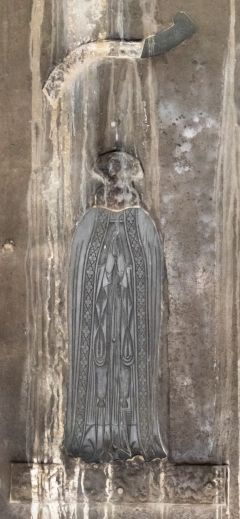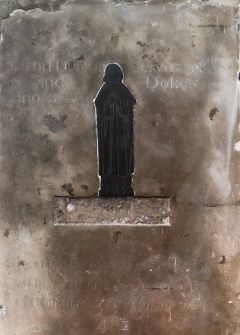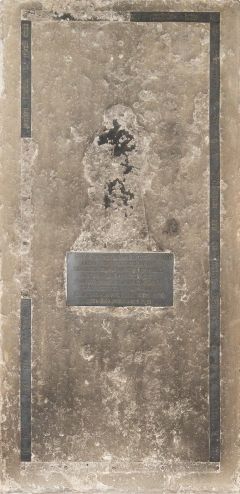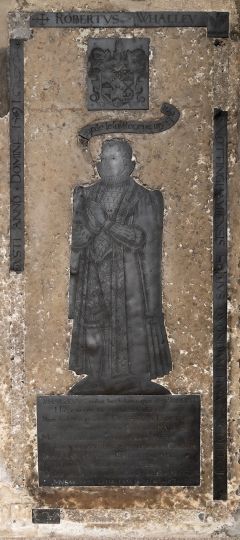Four ancient monumental brasses have survived at Queens’ College.
Originally they would have been on stone slabs on the floor of the Old Chapel. In 1643, many monuments in the chapel, perhaps including some of these, were damaged by the iconoclast William Dowsing and his men. During the chapel reconstruction works of 1773–5, many monuments were displaced, and some moved into the ante-chapel. In 1925, the four remaining brasses were moved to the walls of the ante-chapel of the new Chapel, so that the old chapel could be refurbished as a lecture room: the old chapel is now the student library.

The stone slab has been disfigured by a modern water leak, but the brass itself is mostly undamaged.
The brass of the figure’s head, and of the foot-plate, has been lost, and the brass of the scroll has been partially lost. The surviving part of the scroll reads:
……inopinate
……vigilate. et ꝓ me qͤſo orate
……unforeseen
……be alert. pray for me, please
 2. A small monumental brass of a figure with long hair, in a cassock and academic gown, customarily dated around 1535. The brass of the foot-plate has been lost, so we have no definitive evidence of identity for the effigy.
2. A small monumental brass of a figure with long hair, in a cassock and academic gown, customarily dated around 1535. The brass of the foot-plate has been lost, so we have no definitive evidence of identity for the effigy.
The stone slab has an inscription, which might or might not refer to the figure in the brass. It reads:
Martin Dunstan Servus Mri
Andr: Dokett
Anno Domin
Martin Dunstan Servant of Master
Andrew Dokett
in the year of the Lord
Below the brass is an inscription on the slab unrelated to the brass:
Laur: Catelyn S.T.B.
hujus Coll: Soc: obijt
October 30th 1680 Ætat:
41½
Laurence Cateline S.T.B.
Fellow of this College, died
October 30th 1680 Aged
41½
 3. A monumental brass for John Stokes, President of Queens’, who died in 1568.
3. A monumental brass for John Stokes, President of Queens’, who died in 1568.
The brass of the effigy itself has been lost. The foot-plate, in black-letter script, reads:
Condit’ hoc triſti corpus (venerando) ſepulchro
Lautaqꝫ ieiunis vermibus eſca manet.
Aſt animam cœlo ſuſcepit Chriſtus, et illam
Fidimus a dextris conſtituiſſe patri.
Nam tua viuacis fidei argumenta fuerūt
Facta, Dehinc omni concelebranda die.
Funde preces, alios ut Chriſtus ſemper in ævū
Preclare iſtius prouocet acta ſequi:
Your body is buried under this sad tomb, venerable man,
and it is due to be happy food for hungry worms.
But your soul Christ took up to heaven, and
we have faith that it takes its place on the right hand of the father.
For your deeds were proof of living faith,
and are hereafter to be celebrated every day.
Pour forth prayers, so that Christ may always and for ever
provoke others to follow this man’s outstanding deeds.
The border reads:
Johannes Stokes sacre theologiæ profeſsor huius Col:
legii Magiſter obiit Aº Dni M Vº lxviij Aprilis xxixº, qui quatuor diſcipulos fundavit in hoc Collegio et ſingu:
lis ſeptimanis ſex denarios legavit ex Tenementis
et terris in Ockley quas ſub morte Collegio dedit ad valorem ixl xiijs iiijd et multa præclara beneficia in Collegiū cōtulit.
John Stokes, Professor of Sacred Theology and Master of this College,
died on 29 April in the year of the Lord 1568, who founded four studentships in this College and
left sixpence every week from his tenements and lands in Oakley,
which he gave to the College near his death to the value of £9 l3s 4d and bestowed many outstanding acts of kindness upon the College.
 4. A monumental brass for Robert Whalley, a Fellow of Queens’, who died in 1591. Unusually, for a monument to an academic in a college chapel, the effigy is shown in secular dress of the high fashion of the period. The inscribed foot-plate reads:
4. A monumental brass for Robert Whalley, a Fellow of Queens’, who died in 1591. Unusually, for a monument to an academic in a college chapel, the effigy is shown in secular dress of the high fashion of the period. The inscribed foot-plate reads:
WHALLEYVS cubat hic (fidum caput ille) ROBERTİ
Hic cineres, hîc et dulciter oſſa cubant.
Illum ſydereo prudens DEVS inſerit HORTO
VERE: ſenem nec enim ſerior uſsit HYEMS.
Mos erat auricomis ViVo colludere MVSİS.
Iamqꝫ noVo ANGELİCİS certat honore CHORİS
Fælix PLANTA: Tua tellus radice ſuperbit.
Ipſa ſed aereis ſurgis in alta comis.
Dulce cuba æternum, constans et amabile PECTVS
MVSARVM et CHARİTVM hoc in tumulo TVMVLVS.
Whalley lies here (that faithful fellow);
here pleasantly lie Robert’s ashes, here too his bones.
God in his providence placed him in the celestial garden
during spring, for no later winter ever blasted the old man.
It was his custom when alive to sport with the golden-haired Muses;
and now he competes for honour with the choir of angels.
Blessed plant: the earth takes pride in your root.
But you yourself surge with lofty foliage into the heights.
Sleep sweetly for ever, constant and loveable soul,
a tomb of the Muses and the Graces in this tomb.
The border reads:
✠ ROBERTVS WHALLEY
GENEROSVS NOTTİNGHAMİENSİS SOCİVS QVONDAM HVİVS COLLEGİJ̇
OBİJ̇T ANNO ÆTATİS SVÆ
VİCESSİMO OCTAVO ⅩⅧ DİE AVGVSTİ ANNO DOMİNİ 1591
✠ Robert Whalley,
gent., of Nottingham, formerly a Fellow of this College,
died in his 28th year
on 18 August in the the year of the Lord 1591.
The scroll reads:
Lorde Ieſu receue my sperit
Credit
Translations above in italics provided by Dr David Butterfield.
Further reading
1751: Collectanea Cantabrigiensia, by Francis Blomefield, pp. 139–141. (OCLC 228738533) [chapel monuments]
1753: The History of the University of Cambridge, from its Original, to the year 1753, by Edmund Carter, pp. 184–5. (OCLC 49003331)
1815: A History of the University of Cambridge, its Colleges, Halls, and Public Buildings by William Combe, pub. Rudolph Ackermann, Vol. 1, pp. 250–3. (OCLC 3229135)
1837–42: Le Keux’s Memorials of Cambridge, by Thomas Wright and Harry Longueville Jones, Vol. 1, pp. 256, 259–64. (OCLC 4007853)
1846: A list of the monumental brasses remaining in England, by Charles Robertson Manning, p. 11. (OCLC 20681636)
1847: Recollections and historical notices of Cambridge, by Joseph Kidd Walpole, pp. 97–8. (OCLC 18275646)
1857: A list of the Sepulchral Brasses of England, by Justin Thomas Simpson (d. 1896), p. 13. (OCLC 11824709)
1861: A manual of monumental brasses, by Herbert Haines, Part 1; ibid. Part 2, Queens’ at p. 32. (OCLC 55782299)
1871: The History of the Queens’ College of St Margaret and St Bernard …, by William George Searle, Vol. 2, pp. 298–9 (OCLC 3279381); [Stokes brass]
1871: ibid, p. 302. [Dokett brass repair?]
1886: The Architectural History of the University of Cambridge, by Robert Willis and John Willis Clark, Vol. 2, pp. 36–43. (OCLC 6104300)
1896: The Brasses of Cambridgeshire, Part 2, by C.J.P. Cave, Oswin John Charlton & R.A.S. Macalister, in Trans. Monumental Brass Society Vol. II Part 7 No. XVII, pp. 270–2. (ISSN 0143-1250)
1903: A list of palimpsest brasses in Great Britain, by Mill Stephenson, pp. 19–20. (OCLC 11824760)
1926: A list of Monumental Brasses in the British Isles, by Mill Stephenson, p. 57. (OCLC 3652492)
1938: ibid., Appendix, by Montague Spencer Guiseppi (1869–1953) and Ralph Hare Griffin (1854–1941), p. 725.
1951: An account of the University Collection of Brass Rubbings …, by Gordon Alexander Egerton Ruck (1906–1977), in Proc. C.A.S. XLIV(1950), pp. 33–46, Queens’ pp. 38–40. (ISSN 0309-3603) [Whalley brass changes]
1959: An Inventory of the Historical Monuments in the City of Cambridge, by the Royal Commission on Historical Monuments (England), Part II, p. 170. (online version)
1977: Memorial Brasses: The Memorials, by Malcolm Watson Norris (1931–1995), Vol. 1, pp. 187, 232. (ISBN 978-0-9503942-1-3)
1980: Palimpsests : the backs of monumental brasses, by John Caulfeild Page-Phillips (1930–1992), Vol. 1, p. 74. (ISBN 978-0-9501298-4-6)
1991: ibid., Addendum 6, p. 38, in Bulletin of the Monumental Brass Society, No. 58, 1991 October. (ISSN 0306-1612)
1981: The Figure Brasses of Cambridgeshire, by Peter John Heseltine (1939–2013), pp. 3, 8, 10, 22. (ISBN 978-0-9507623-0-2)
1994: Heraldry on brass : The Mill Stephenson Collection of Shields of Arms on British Brasses …, by Peter John Heseltine (1939–2013), p. 13. (ISBN 978-0-9524370-0-0) [Arms on Whalley brass]
1995: The Monumental Brasses of Cambridgeshire, by William Greenfield Lack (1945–2019), Howard Martin Stuchfield, Philip Whittemore, pp. 47–51. (ISBN 978-0-9523315-0-6)